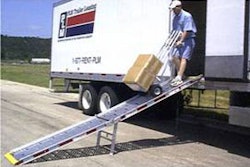Green Bay, WI: Long hours behind the wheel and a continual assault on their bodies that can be aggravated by road vibrations, erratic sleep and unhealthy diets, make commercial drivers among the most vulnerable to injury of all those in private-sector jobs.
In a number of independent studies by Atlas Ergonomics, Grand Haven, MI, 85 percent of truck drivers reported some discomfort. Half reported pain in their shoulders, lower backs and heads or necks; more than a third reported pain in their knees, hands and wrists. Just one of these injuries, on average, can cost an employer $84,000 to $168,000, not including lost revenue caused by missing drivers, according to Atlas’ research.
By implementing Atlas’ in-cab ergonomics program for its truck drivers, though, Green Bay, WI-based Schneider National in 2005 reduced its workers’ compensation costs by more than 9 percent. At the same time, the percentage of Schneider drivers reporting job-related discomfort dropped by more than 47 percent. Drivers have reported higher job satisfaction, less fatigue and a greater ability to drive safely.
At the core of the Atlas program is education that seeks to familiarize drivers with the adjustments they can make to seats, steering wheels and other cab components for better ergonomics. The Atlas system can map cabs specific to each truck and driver, and then measures remaining discomfort, identifies specific drivers who require special attention and recommends appropriate actions.
"At Schneider, 'Safety First and Always' is our primary core value," says Don Osterberg, vice president of safety and driver training. "We moved forward with the Atlas system to keep our drivers more safe and comfortable. The Atlas Seat Marking System provides an opportunity for our drivers to use the full value of their seats whereby, drivers feel better, perform better and are less fatigued. We knew we had succeeded when we saw 114 fewer lost-time injuries."
Osterberg explains further, "At the start of the program, our objective was simply to help our drivers, and the financial impact was less clear. After six months, we were confident that we’d seen a favorable return on our investment."
"We are certainly very pleased with Schneider's results so far," says Drew Bossen, executive vice president of Atlas Ergonomics. "We believe, however, much more can be accomplished. We now have over 15,000 driver surveys, which provide invaluable data telling us where driver discomfort occurs and why. We are now using that data to identify root cause issues and define solutions to further improve performance."
In general, companies that have implemented the Atlas system have seen 75 percent fewer reports of driver discomfort and 70 percent fewer complaints of back, shoulder and neck pain by drivers. In addition, 65 percent of drivers reported higher job satisfaction and productivity, 70 percent reported less fatigue, and 84 percent said it had an affect on their ability to drive safely.


















